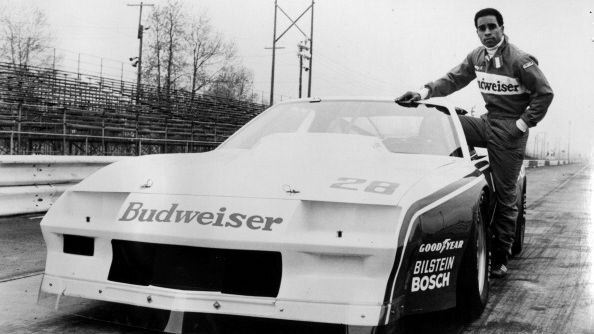
Five Black Racers You Should Know

In honor of Black History Month, ExoConsulting researched, debated, and decided on our top five Black racers through the history of motorsports, based on accomplishments on and off track. The racers selected are in alphabetical order with one exception: Lewis Hamilton, our Number One, who is both an amazing driver and a stellar role model for the Black community.

Lewis Hamilton
The 36-year-old British driver Sir Lewis Carl Davidson Hamilton began racing at age five when his dad bought him a radio-controlled car. Being the only Black member of the RC racing club, he was subjected to racism at a young age. The next year, Lewis received a go-kart for Christmas and was promised that he could race it, if he kept his grades up.
In 1998, Hamilton signed with McLaren’s young driver program at the age of 13. By 2007, he became the first Black driver to compete in Formula One. Hamilton became the youngest driver ever to win an F1 title.

His success continued after his 2013 move to Mercedes, winning six more titles.
The racism Hamilton experienced at a young age has continued through his career, which has driven him to speak out. In 2020, he founded The Hamilton Commission in collaboration with the Royal Academy of Engineering to increase Black inclusion in motorsports.

Cheryl Linn Glass
Born in 1961, Cheryl Linn Glass was the first Black female professional racing driver in the United States. Glass bought her first race car with money she earned making and selling ceramic dolls for between $150-300 each. (In 2020 dollars, she would have earned $1,000 to $2,000 per doll.)
At 18, Glass became the first woman to compete in sprint cars and was the Northwest Sprint Car Association Rookie of the Year. Glass went on to compete in over 100 races. In 1990, she advanced to the Indy Lights series and was the first Black woman to compete in that series. Her career ended in 1991 after a crash at Phoenix.

The sexism and racism she suffered continued even after her racing ended. She survived a home invasion during which she was raped and the assailants drew a swastika on the wall with her lipstick. The turmoil in her life included incidents with neighbors and police. At 35, Glass jumped off the Aurora Bridge in Seattle. Her death was ruled a suicide. Family members dispute that finding.

Willy T. Ribbs
When you look at Ribbs’ resume, you see a true wheelman. His racing ranged from open wheel to sports cars to NASCAR, finding his most success in the Trans Am Series. In his early years, Ribbs was learned about the world of motorsports through his dad, who was an amateur sports car racer. At 21, Ribbs moved to Europe, winning the championship of the 1977 Dunlop/Autosport Star of Tomorrow FF1600 series.

Ribbs’ first chance to race in NASCAR was in 1978, when he was entered into the World 600 by Charlotte Motor Speedway president Humpy Wheeler in an effort to attract Black fans. Even with Wheeler’s support, Ribbs ran into issues due to his lack of NASCAR experience and missing two practice sessions, plus allegations that Ribbs led police on a high-speed chase. Ribbs was replaced in the car by Dale Earnhardt.
In 1985, he attempted to be the first Black driver to compete in the Indianapolis 500. However, in a second-hand Cosworth, Ribbs’ maximum speed was 170 mph, while others ran in excess of 200 mph. His team withdrew from the race. Team owners continued to recognize his talent, and in 1986 he drove in four NASCAR Cup races. That year, during a test session in Portugal, Ribbs became the first Black driver to pilot a Formula One car. In 1991, he became the first Black driver to qualify for the Indianapolis 500. Ribbs continued to race through 2000 when he drove in the NASCAR Truck Series.

Wendell Scott
In 1953, NASCAR Hall of Famer Wendell Scott became the sports’ Jackie Robinson when he earned his NASCAR license. He was born in 1921 in Danville, Virginia. After serving in World War II, Scott opened an auto repair shop. He, like other stock car peers, used his driving skills for running moonshine.
Scott advanced through the NASCAR ranks, reaching the Grand National Series in 1961. In 1963 at Speedway Park in Jacksonville, Florida, he passed Richard Petty with 25 laps to go. Scott went on to win the race, but NASCAR declared Buck Baker the winner. Two hours after the completion of the race, officials noted that not only had Scott won, but Baker was actually two laps down at the completion of the race. The win was not officially changed until 1965, making Scott the first Black driver to win in NASCAR.

The trophy was awarded to Scott’s family in 2010, twenty years after his passing.
Scott’s success in NASCAR peaked in 1966 when he finished sixth in the standings. His NASCAR career ended in 1973 due to injuries sustained at Talladega. He was inducted into the NASCAR Hall of Fame in 2015.

Bubba Wallace
Born William Darrell Wallace in 1993, Wallace started racing Bandolero and Legends cars at nine years old. At 11, he won 35 of the 48 Bandolero races during the 2005 season. By 2010, he was participating in NASCAR’s Drive for Diversity program, as well as becoming a Joe Gibbs Racing development driver. In 2013, with a win at Martinsville, Wallace became the first Black driver to win in the Camping World Truck Series and only the second Black driver to win in one of NASCAR’s top three national series.

Wallace has spoken out against police brutality and in support of the Black Lives Matter movement. In June 2020, Wallace was thrust into the national spotlight when a garage pulldown rope was found tied into a noose at Talladega Superspeedway in his garage stall. In 2021, Wallace joined 23XI Racing, a NASCAR Cup team founded by Michael Jordan and Denny Hamlin.
Honorable Mentions: Rajo Jack, Bill Lester, and Charlie Wiggins

Reach out today and let’s find ways to work together.
Since 2003, ExoConsulting’s founder, Dr. Aaron Studwell, has been providing weather support to the NASCAR community, building his reputation as an effective communicator with a passion for the sport and the people in it. Marketing and Social Media Coordinator Stevie Thompson brings her insight and artistic flair to engage our client base. Together, we provide technical expertise and business insights for client success on and off track. Let’s find ways to work together.
Written by Aaron Studwell, February 22, 2021
If you have made it this far, kudos! And thank you!





